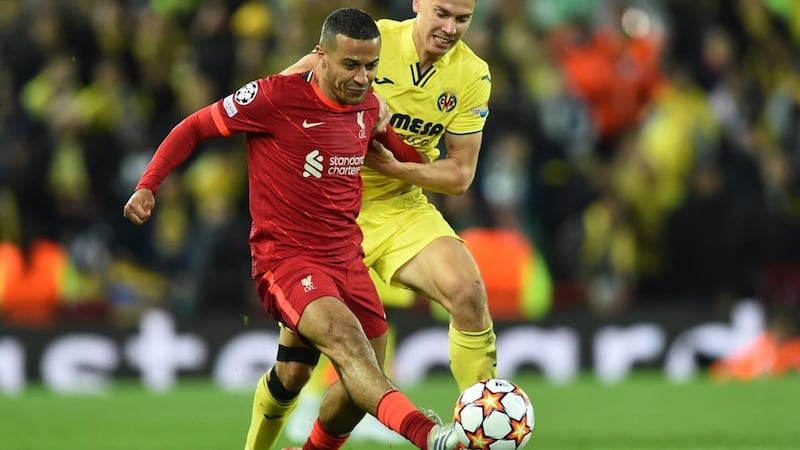With no more daring option immediately apparent, Diogo Jota decided to turn around and start again. There were about a dozen minutes remaining, and Liverpool had long ago entered energy-conservation mode. Jürgen Klopp’s team had, in the blink of an eye, established a two-goal lead over Villarreal in the first leg of their Champions League semi-final, and it had no intention of surrendering it.
So Jota, as he picked up the ball on the left wing and saw his path was blocked by two defenders, took the safety-first choice. He slipped a pass back across the halfway line. Virgil van Dijk took possession, and play moved off toward the other side of the field. At that point, Thiago Alcantara decided to offer his teammate some instant feedback on his decision.
He explained – or, at least, seemed to be explaining – to Jota that while van Dijk was a fine selection, he had been open and available, too, and technically, if he was being picky, in a better position. The correct choice, in that situation, would have been passing to Thiago. This is because the correct choice, in pretty much every situation, is passing to Thiago.

It is hard to be certain what, exactly, lies at the root of soccer’s relatively recent but now all-consuming obsession with yield. The game has, in the past decade or so, developed an apparently devout belief that if something cannot be measured that it cannot matter; a player’s worth can be accurately gauged by boiling down their output into something concrete, something definite, some number or percentage that offers the illusion of proof.
The temptation is, of course, to connect that tendency to the sport’s growing interest in and reliance on analytics – this is soccer, as the nerds wanted it – or even to the game’s continuing infiltration by people who can only be described as Americans. That may, though, offer only a partial explanation.
Just as relevant, perhaps, is the game’s talking-point culture, its entrenched tribalism and endless squabbling for supremacy, its thirst for virality, attention and clout. Cold, hard numbers carry more weight in 280 characters, after all, than such outdated concepts as metaphor, or allusion.
Whatever the cause, few have been boiled down to a succession of numbers quite so much as Thiago. In his first season-and-a half in England, it was generally a convenient stick with which to beat him: His goal and assist tallies, after all, hardly indicated that he was a valuable component of Liverpool, let alone an outstanding performer.

Belatedly, in the past few weeks, the dynamic has changed. Thiago had a pass completion rate of 92 per cent in the FA Cup semi-final victory against Manchester City. He played 129 passes in the most recent humbling of Manchester United, and 123 of them found their intended target.
A few days ago, he made more successful passes against Everton than all of his opponents combined. And then, against Villarreal, he turned in 119 touches, 103 passes played, 99 passes completed, 100 per cent of tackles won, five interceptions, nine long balls completed and one earnest feedback session with a slightly unwilling Diogo Jota.
Every single one of those passes did something: They changed the angle of attack or relieved the pressure or switched gear or altered speed. To reduce them to mere numbers is to miss their point
The problem, of course, is that none of those metrics capture what makes Thiago such an integral part of this version of Klopp’s Liverpool. It is not just that they do not take into account his habit of urging the crowd to maintain its energy, or the way he walks his teammates through a game, or his ability to change something as ethereal and intangible as the feel of an occasion with something as simple as a tackle.
It is that they do not tell you what any of those passes did. They do not distinguish between the ones played with the inside of his foot and the ones curled from the outside, the ones that keep things ticking over and the ones that slice through a defensive line, the ones that sweep and boom over vast distances, landing unerringly on some grateful recipient’s foot, and the ones that fizz low, at unexpected speed, suddenly launching Liverpool into another attack.
They do not advertise which ones start with that quick shimmy of the hips, the one that begins with Thiago facing one direction and ends with him scampering in the other, at least two defenders trailing in his wake, still processing what has happened. They do not capture how unfazed he is by even the most intense pressure, or how flawless his technique is, and they do not begin to touch on the art with which he accomplishes his craft.
Nor, of course, do they tell the story of how Thiago has come to encapsulate the growth and the maturation of Klopp's Liverpool. The first team that Klopp took to the Champions League final, the one that suffered that heart-aching defeat to Real Madrid in 2018, was one that embraced chaos; it had still not, quite, cast off that misleading cliche about its manager and his percussive, heavy metal soccer.
The second, the one that returned to the final the following year and left with substantially happier memories, did so by harnessing that chaos; a team of crest and surge, it could pick and choose its moments, unleashing the power and energy that it had once allowed to run uncontrolled in deliberate, irresistible bursts.
This iteration should become the third Liverpool team in five years to reach the Champions League final – all they have to do, after all, is not lose by two goals next week – but it is conceptually distinct from both its predecessors. This Liverpool is defined more by control than by chaos, more by patience than percussion.
They needed those virtues against Villarreal, a team whose romantic adventure to this stage should not, by any means, be confused with a desire to make friends now that they are here. Liverpool had to wait. They had to think. They had to adapt. They had to get a fortuitous deflection on a Jordan Henderson cross to break the dam, and then they had to strike again, almost instantaneously, before Unai Emery had a chance to repair the leak.
There are few midfielders in Europe better suited to that task than Thiago. Every single one of those passes did something: They changed the angle of attack or relieved the pressure or switched gear or altered speed. To reduce them to mere numbers is to miss their point. They are better read, instead, as brushstrokes on a canvas, each one making the image a little clearer, each one signed by a master at work. – This article first appeared in The New York Times




















